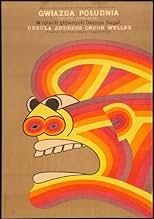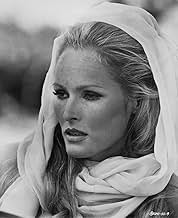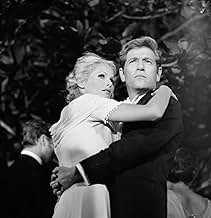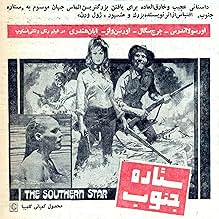VALUTAZIONE IMDb
5,4/10
659
LA TUA VALUTAZIONE
Aggiungi una trama nella tua linguaIn 1912 West Africa, diamond tycoon Kramer hires penniless American fortune hunter Dan Rockland, who's posing as a geologist, but when a huge diamond is found, everyone wants to steal it.In 1912 West Africa, diamond tycoon Kramer hires penniless American fortune hunter Dan Rockland, who's posing as a geologist, but when a huge diamond is found, everyone wants to steal it.In 1912 West Africa, diamond tycoon Kramer hires penniless American fortune hunter Dan Rockland, who's posing as a geologist, but when a huge diamond is found, everyone wants to steal it.
- Regia
- Sceneggiatura
- Star
Georges Géret
- André
- (as George Geret)
Sylvain Levignac
- Louis
- (as Sylvain)
Jacques Van Dooren
- Man in Bar
- (non citato nei titoli originali)
Recensioni in evidenza
The Southern Star is based on a novel by Jules Verne ,one published under a number of different titles .It is most widely known by the title used in the movie but has also been published as "The Southern Star Mystery" and "The Vanished Diamond".
The setting is French West Africa(changed from South Africa in the novel) and the period is immediately before the outbreak of World War One. The star is a large diamond which goes missing and is found by banjo playing American geologist Dan (George Segal).It is actually the property of business tycoon Kramer (Harry Andrews) whose daughter Erica (Ursula Andress)Dan is in love with .Complicating matters is the fact that Kramer's head of security Karl(Ian Hendry)is also after both the diamond and Erica and has a large force of men to ensure he gets both .In particular he has a sidekick Plankett (Orson Welles) a ,man fond of drilling his troops to records of bugle music .
The greatest asset of the movie is its striking location photography of Senegal which ensures the movie is always good to look at .It is also pretty well acted -although I did wonder how Ursula Andress managed to get her hands on full make up ,including mascara ,in the jungle .Welles in particular seems to be enjoying himself hugely .
the action when it comes is fine and the movie has a lot of humour -which is my big problem with it .I prefer my period adventure straight and details like the banjo playing and bugle records grate on me a tad Its a minor grouse ,nothing more and the movie is an enjoyable romp that may have relatively little to do with Verne but is a pleasant diversion on a wet and windy afternoon
The setting is French West Africa(changed from South Africa in the novel) and the period is immediately before the outbreak of World War One. The star is a large diamond which goes missing and is found by banjo playing American geologist Dan (George Segal).It is actually the property of business tycoon Kramer (Harry Andrews) whose daughter Erica (Ursula Andress)Dan is in love with .Complicating matters is the fact that Kramer's head of security Karl(Ian Hendry)is also after both the diamond and Erica and has a large force of men to ensure he gets both .In particular he has a sidekick Plankett (Orson Welles) a ,man fond of drilling his troops to records of bugle music .
The greatest asset of the movie is its striking location photography of Senegal which ensures the movie is always good to look at .It is also pretty well acted -although I did wonder how Ursula Andress managed to get her hands on full make up ,including mascara ,in the jungle .Welles in particular seems to be enjoying himself hugely .
the action when it comes is fine and the movie has a lot of humour -which is my big problem with it .I prefer my period adventure straight and details like the banjo playing and bugle records grate on me a tad Its a minor grouse ,nothing more and the movie is an enjoyable romp that may have relatively little to do with Verne but is a pleasant diversion on a wet and windy afternoon
Say Jules Verne and one has memories of cannons shooting men to the moon, or a mad sea captain destroying British ships with his personal submarine, or a proper Englishman betting 20,000 lbs (half his fortune) that he can get around the world in 80 days. And the movies have been kind to Verne's best known films: George Melies immortalized FROM THE EARTH TO THE MOON in an early film. Walt Disney did films on TWENTY THOUSAND LEAGUES UNDER THE SEA and THE CHILDREN OF CAPTAIN GRANT (the latter entitled IN SEARCH OF THE CASTAWAYS). Ray Harryhausen's special effects are one of the treats of MYSTERIOUS ISLAND. Mike Todd produced AROUND THE WORLD IN EIGHTY DAYS. And James Mason did make that JOURNEY TO THE CENTRE OF THE EARTH. What is usually not realized is the lesser known titles that have gotten onto the screen - for Jules Verne wrote nearly 80 novels. MICHAEL STROGOFF was made into a film in Great Britain in the 1930s with Anton Walbrook. FIVE WEEKS IN A BALLOON was made into a comedy adventure (with Sir Cedric Hardwicke and Red Buttons) in the 1960s. A Mexican version of the long forgotten EIGHT HUNDRED LEAGUES OVER THE AMAZON was made in the 1950s. A French version of MATTHIAS SANDORF (Verne's attempt at an updated version of THE COUNT OF MONTE CRISTO) was made starring Louis Jordan in the 1960s. And there was this little film, made in 1969.
What is frequently forgotten about Verne was that he was as preoccupied with politics as scientific developements. He usually was a liberal (one remarkable exception was his anti-Semitism, most markedly shown in his novel OFF ON A COMET - he also was convinced for years that Alfred Dreyfus was a traitor). In a late novel, THE DANUBE PILOT, he looks at the various warring nationalities in the Balkans and Austria Hungary. Another novel, THE SURVIVORS OF THE JONATHAN, dissects the various political philosophies of the day (Verne's hero is an anarchist). In the original THE SOUTHERN STAR Verne was taking a jaundiced eye at his particular bete noir - the British Empire in South Africa. The Boer - British rivalry there are a sounding board for looking at the society of South Africa. But one element is missing from the film. The villain is described as looking like Cecil Rhodes. But the villains in the film don't look like Rhodes.
Yet the film does get the relations of the three groups (native Africans, Boers, British) into some proportion. Ian Hendry is the real villain, having slowly made his way into a position of power over the career of his predecessor (and former patron) Welles, and hoping to take over Harry Andrews economic empire. Hendry romances Andrews niece, Andress, who is in love with Segal. As for Segal, he is friendly with Johnny Secca, who grew up with him. Andrews disapproves of this friendship, and Hendry detests the native Africans anyway. Andrews' diamond works has just produced the world's largest diamond - the "Southern Star". It is stolen and suspicion (fed by Hendry, and swallowed by Andrews) is that Secca stole it. Segal tries to help his friend (who is fleeing). Then Welles returns - he hopes to force Secca to give him the diamond, so he can regain his old position with Andrews.
The film is actually interesting enough to watch to its conclusion (and actually satisfactory even for Welles, as ambiguous a villain here as in some of his own films). It is not a great film by any stretch, but I would recommend seeing it.
What is frequently forgotten about Verne was that he was as preoccupied with politics as scientific developements. He usually was a liberal (one remarkable exception was his anti-Semitism, most markedly shown in his novel OFF ON A COMET - he also was convinced for years that Alfred Dreyfus was a traitor). In a late novel, THE DANUBE PILOT, he looks at the various warring nationalities in the Balkans and Austria Hungary. Another novel, THE SURVIVORS OF THE JONATHAN, dissects the various political philosophies of the day (Verne's hero is an anarchist). In the original THE SOUTHERN STAR Verne was taking a jaundiced eye at his particular bete noir - the British Empire in South Africa. The Boer - British rivalry there are a sounding board for looking at the society of South Africa. But one element is missing from the film. The villain is described as looking like Cecil Rhodes. But the villains in the film don't look like Rhodes.
Yet the film does get the relations of the three groups (native Africans, Boers, British) into some proportion. Ian Hendry is the real villain, having slowly made his way into a position of power over the career of his predecessor (and former patron) Welles, and hoping to take over Harry Andrews economic empire. Hendry romances Andrews niece, Andress, who is in love with Segal. As for Segal, he is friendly with Johnny Secca, who grew up with him. Andrews disapproves of this friendship, and Hendry detests the native Africans anyway. Andrews' diamond works has just produced the world's largest diamond - the "Southern Star". It is stolen and suspicion (fed by Hendry, and swallowed by Andrews) is that Secca stole it. Segal tries to help his friend (who is fleeing). Then Welles returns - he hopes to force Secca to give him the diamond, so he can regain his old position with Andrews.
The film is actually interesting enough to watch to its conclusion (and actually satisfactory even for Welles, as ambiguous a villain here as in some of his own films). It is not a great film by any stretch, but I would recommend seeing it.
The Southern Star in question is the world's biggest diamond found in 1912 in French West Africa in a mine owned by Kramer (Andrews), whose daughter Erica (Andress) is engaged to Dan (Segal). The diamond is stolen and the chief suspect Matakit (played engagingly by Johnny Sekka), Dan's klepotomanic African friend, takes off. Dan and Erika take off after Matakit and the diamond. Karl, Kramer's security chief (Hendry), takes off after Dan, Erika Matakit and the diamond, hoping to win Erica in the process. To get to his home Matakit must cross territory controlled by Plankett (Welles), Karl's renegade predecessor.
We get to see lots and lots of sixties stock footage of African animals, we get to Andress topless, we get to see Welles ham it up. What we don't get is a good film. If you've nothing better to do for two hours on a wet afternoon you could do worse but you really should have something better to do.
The only reason I watched this dross was because I saw the magic name "Orson Welles" in the list of actors appearing (of which more below).
To start on a (the only really!) bright note, the footage of wildlife is very good indeed (although it feels as if this was taken from elsewhere and when the actors are anywhere near real wildlife (apart from the tame ostrich), it consists of dummies/props (Segal and the plastic "crocodile" in the river and Andress swimming quietly past a wallowing herd of hippos at a distance of a few feet in a river (fat chance, she would have been dead in about two minutes, killed by what are actually THE most dangerous animals in the whole of Africa - forget lions and cheetahs!) Apart from the quality of the photography, the NUMBER of animals in each shot is also very impressive; massive herds of hippos, elephants, prides of lions, herd of ostriches etc. I fear this shows how much wildlife has been lost between when the film was made (1969) and now (2020), as nature programmes never seem to show most animals in those numbers these days!
To move on to the human actors; these are largely as are to be expected. I always expect VERY little indeed from George Segal (who must have been one of THE luckiest actors of his time, with everything resting on his photogenic looks), Ursula Andress (eye candy embodied) and Ian Hendry (ALWAYS playing every role in precisely the same way). A disappointment was Harry Andrews. I usually find him a magnetic actor to watch and one who, no matter who the lead star is, seems capable of stealing every scene he appears in. In this case, however, he goes WAY OVER THE TOP and his booming, laughing, lecherous, somewhat sadistic interpretation just did not work for me.
Which brings us to the figure of Welles; absolutely huge/grossly obese at this time (as in "A Ferry to Hong Kong", made shortly before) and obviously just "winging it" in terms of putting any life at all into his part (even though this is admittedly very slim and he does not even appear until about half way through the movie). I felt really sad at seeing him having to take parts in such dross as this, particularly remembering that this was only a few years after two of the (in my view) finest films he ever made: "Chimes at Midnight" (which virtually everyone must agree is a masterpiece) and "The Trial" (which some people (e.g. Charles Higham) certainly do not regard as a masterpiece but which I do in terms of style and cinematic finesse). As Charlton Heston (who starred in another of Welles' undoubted masterpieces, "Touch of Evil") once said in an interview, instead of wasting his enormous talents on dross like this, Welles should have focused on finding a patron or sponsor who admired his work (although being Welles, of course, he would probably never have accepted his position in such a relationship for long in any case!)
A very final thing I found abysmal: the MUSIC/soundtrack is beyond horrendous -cheap muzzak, recorded at ear-splitting levels for much of the film and thrown in at what mostly seemed totally inappropriate moments!
Overall. a REAL turkey and one I am guaranteed never to waste two hours watching again in my life (even with Welles in it)!
The picture is set in West Africa where we find a roguish geologist adventurer ( George Segal ) and his helper ( Johnny Sekka ), there both of whom encounter a hot rock . But the gem is nevertheless ownership a magnate ( Harry Andrews ) whose gorgeous daughter ( Ursula Andress )is enamored the rogue adventurer . The chief ( Ian Hendry ) of his private troops schemes to get the girl and the diamond . Besides , an ex-security chief ( Orson Welles ) equally tries to steal the precious gem .
This amusing film displays action , adventures , humor , rip-roaring and lots of fun . The movie is narrated by means of a continuous pursuit in the jungle and we are seeing several African animals although the most by an excessive use of stock-shots , thus stampeding buffalo , elephants , gnus, lions , snake... and a peculiar thief ostrich . This unknown motion picture obtained limited success in spite of a first-rate cast and result to be immensely agreeable . The tale based on Jules Verne novel is regularly directed by Sidney Hayers . Rating : Average but entertaining . It's a good stuff for young people who enjoy enormously with the extraordinary adventures in the lush jungle.
This amusing film displays action , adventures , humor , rip-roaring and lots of fun . The movie is narrated by means of a continuous pursuit in the jungle and we are seeing several African animals although the most by an excessive use of stock-shots , thus stampeding buffalo , elephants , gnus, lions , snake... and a peculiar thief ostrich . This unknown motion picture obtained limited success in spite of a first-rate cast and result to be immensely agreeable . The tale based on Jules Verne novel is regularly directed by Sidney Hayers . Rating : Average but entertaining . It's a good stuff for young people who enjoy enormously with the extraordinary adventures in the lush jungle.
Lo sapevi?
- QuizThe rope bridge over the river is still intact in the Niokolo Koba National Park in Senegal and supports up to four people.
- Curiosità sui creditiOpening credits prologue: FRENCH WEST AFRICA 1912
- Colonne sonoreThe Southern Star
Title Song Sung by Matt Monro
Music by Georges Garvarentz (uncredited)
Lyrics by Don Black
Performed by Georges Garvarentz Et Son Orchestre (uncredited)
Arranged by George Martin (uncredited)
Orchestrated by George Martin
I più visti
Accedi per valutare e creare un elenco di titoli salvati per ottenere consigli personalizzati
- How long is The Southern Star?Powered by Alexa
Dettagli
- Data di uscita
- Paesi di origine
- Lingua
- Celebre anche come
- The Southern Star
- Luoghi delle riprese
- Niokolo-Koba National Park, Senegal(filmed in Senegal)
- Aziende produttrici
- Vedi altri crediti dell’azienda su IMDbPro
- Tempo di esecuzione
- 1h 44min(104 min)
- Mix di suoni
- Proporzioni
- 2.35 : 1
Contribuisci a questa pagina
Suggerisci una modifica o aggiungi i contenuti mancanti




























